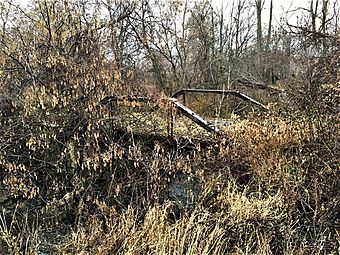Stony Creek Bridge facts for kids
The Stony Creek Bridge is a special old bridge located in Olive Township, Clinton County, Michigan. It crosses over Stony Creek on a private road. This bridge is very important because it's the last one of its kind, called a queen post truss bridge, left in Michigan! It was added to the National Register of Historic Places in 1999, which means it's recognized as a historically important structure.
Quick facts for kids |
|
|
Stony Creek Bridge
|
|
 |
|
| Location | Private road over Stony Creek, Olive Township, Clinton County, Michigan |
|---|---|
| Area | less than one acre |
| Built | 1880 |
| Architectural style | Queen post pony truss bridge |
| MPS | Highway Bridges of Michigan MPS |
| NRHP reference No. | 99001467 |
| Added to NRHP | November 30, 1999 |
Contents
History of the Stony Creek Bridge
The Stony Creek Bridge was built in 1880. It was first used to carry what is now Dewitt Road over Stony Creek.
Later, Dewitt Road was changed to a new path. A concrete tunnel, called a culvert, was built to guide the creek under the new road. Because of this, the old bridge was no longer needed for the main road. It was then given to a private owner.
What is a Queen Post Truss Bridge?
A queen post bridge is a type of bridge design. It uses a special framework called a "truss" to support its weight. This design helps the bridge span, or cross, a certain distance.
How the Design Works
A queen post bridge has two upright posts, called queen posts. These posts are placed about one-third of the way along the bridge's span on each side. They are connected at the top by a strong horizontal beam.
This is different from a king post bridge, which has only one central post. A diagonal brace also runs from the top of each queen post to the outer edge of the bridge. This design allows queen post bridges to cross longer distances than king post bridges.
A Look Back at History
The queen post truss design is very old. Both king post and queen post trusses were made from wood for many centuries. People used them for roofs and bridges from the Middle Ages through early American history.
This building method spread across the United States as pioneers moved west. Many wooden king and queen post bridges were built in Michigan during the 18th and 19th centuries.
From Wood to Metal
Over time, the basic shape of the bridge stayed the same. However, the materials used to build them changed. Builders started using combinations of wood and iron, and then later, only iron and steel.
Companies began selling iron and steel versions of these bridges. They were seen as strong and affordable ways for local governments to cross short distances.
Why Are They Rare Now?
Queen post trusses could only span a certain range of distances. King posts were for shorter spans, and queen posts were not much longer. After the year 1900, new designs became more popular.
Steel beam bridges became common. Also, metal Pratt truss bridges could span even longer distances. Because of these new designs, no new queen post bridges were built in Michigan. Over time, all the old ones disappeared, except for the Stony Creek Bridge. It is the last one left!
Looking Closely at the Bridge
The Stony Creek Bridge is made of wrought iron. It is a "pin-connected" queen post "pony truss" bridge. A "pony truss" means the truss framework is not as tall as the bridge deck.
The bridge is about 40 feet (12 m) (12 meters) long and 16 feet (4.9 m) (4.9 meters) wide. The part where cars drive is about 14 feet (4.3 m) (4.3 meters) wide. It has a single span, meaning it crosses the creek in one section.
The bridge rests on concrete supports called abutments. These abutments have stone walls, called wingwalls, on their sides. The top part of the bridge's frame is made of double channels. The lower part and the queen posts are made from two special "I-bars" with holes.
Each side of the bridge has a diagonal brace. This brace is a round "eyerod" with a "turnbuckle." A turnbuckle is a device that lets you tighten or loosen the rod. The wooden floor of the bridge, called the "decking," is held up by I-beams. These I-beams hang from the lower truss beam using U-shaped bolts and support steel "stringers" (long beams).




